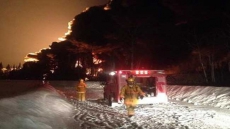When soldiers in the throes of battle discard their rifles and pluck a different weapon from the hands of dead allies, there's clearly a serious problem.
So it was with the Ross rifle, the weapon that Canadian soldiers took with them to the start of the First World War a century ago.
It was the brainchild of Sir Charles Ross, a wealthy Scottish-born engineer and inventor who offered it to the Canadian government as a military firearm well before the war began.
To Sir Sam Hughes, Canada's minister of militia — defence minister in modern parlance — at the time, the Canadian-built Ross was highly accurate and the perfect tool for his soldiers, whom he saw as frontier marksmen.
But troops, some of whom sneered at the rifle as "the Canadian club," soon discovered the Ross was not suited to dirty, rough-and-tumble trench warfare. They preferred the robust Lee-Enfield carried by their British comrades, picking them up from the battlefield when they could.
The .303-calibre, straight-pull Ross was longer than the Lee-Enfield, a problem in the cramped confines of the trenches. It was heavier, too, and in a day when infantrymen were over-burdened, any extra weight was unwelcome. When fired with its bayonet attached, it tended to shed the bayonet.
The Ross was also susceptible to jamming from dust and dirt and was very finicky about the quality of ammunition. The carefully machined cartridges made by the Dominion Arsenal worked fine, but not so the mass-produced British ammunition, which could vary in size beyond the Ross's fine tolerances.
Further, it was easy to reassemble the Ross bolt incorrectly. Even when misassembled, the bolt would fit in the rifle and even chamber and fire a cartridge, only to slam back into the rifleman's face — unheard of for most bolt-action rifles.
"The harsh test of trench warfare served to emphasize the new rifle's imperfections," wrote G. W. L. Nicholson, of the Canadian army historical section.
Ian McCollum, an Arizona-based firearms expert who runs the Forgotten Weapons website, has posted a You Tube video (http://www.youtube.com/watch?v=EaSui_UqDX8) showing how the bolt can be compromised and what happens afterwards. He's had 47,000 hits on the clip.
"I prefer the Ross," he said in an interview. "I don't know that I'd prefer it if I were in a sloggy, muddy trench, but I find the Ross sights are definitely better. I like the Ross action better. It's smoother and faster."
He said the Ross is a good rifle to fire, "provided it doesn't throw the bolt into your head."
"It was designed around Canadian production cartridges, which were quite good," McCollum said. "They decided to stick to the tighter Canadian chamber because it gave them a slightly higher muzzle velocity, which in retrospect was kind of a dumb idea."
The Canadian authorities tried hard to convince the troops that the Ross was a good rifle, but in the spring of 1915, more than 3,000 men discarded the Ross in favour of the Lee-Enfield, despite threats of punishment.
After the gas attack at Ypres that April, an unidentified Canadian officer wrote: "It is nothing short of murder to send out men against the enemy with such a weapon."
An official history says of that battle: "Rifle bolts jammed. Boot heels and entrenching tool handles opened some of them."
The Ross was a highly accurate weapon later prized by snipers and sportsmen. But as a weapon of war in the trenches, it left much to be desired.
"Everything jammed in those circumstances, eventually," McCollum said. "It's just the Ross did it more often than most of the other guns."
Although Hughes defended the rifle vigorously, the 1st Canadian Divisions got rid of their Rosses in 1915. The following year, the British military overrode Hughes's objections and the rest of the Canadians adopted the Lee-Enfield.
"As it was built, it was not the best choice for the Canadian military," McCollum said. "Once they adopted it, it's hard to blame anyone for not wanting to throw them all away and buy a whole new set of rifles."
Championing the Ross helped bring down Hughes, who resigned in November 1916.
"Hughes quite rightly defended the rifle by saying that the real problem was the quality of British ammunition, but this missed the larger point," said Mark Humphries, who holds the Dunkley Chair in War and the Canadian Experience at Wilfrid Laurier University in Waterloo, Ont.
"The Lee-Enfield was a more rugged, reliable military weapon for use in the field while the Ross was a better sporting rifle. But Hughes was not asking Canadian soldiers to go hunting, he was asking them to fight for their lives and in this respect the Lee-Enfield gave them a better chance at survival."
The salvaged Ross rifles were shipped home. Some were sold to hunters. Others were sent to Britain at the start of the Second World War, when any rifle was prized.
Some are still around, hanging on mantles, sitting in collections, or taken out every now and then when hunting season opens.
As for the Lee-Enfield, Canadian soldiers carried it through two more wars before it was retired in 1955.
A selection of quotes about Canada's hated Ross rifle, standard issue in WWI

Some quotes about the ill-fated Ross rifle used by Canadian soldiers during the early years of the First World War:
"They are fantastic rifles for sportsmen." — Ian McCollum, an Arizona-based firearms expert who has experimented with the Ross.
---
"In a number of ways. it got the raw end of the stick, but as it was built it was not the best choice for the Canadian military." — McCollum.
---
"If the Ross was supplied with good Canadian ammo, that wasn't a problem. The problem was there wasn't enough of that ammo and logistics simply dictated that guys with the Ross would end up with British ammo sooner or later." McCollum, explaining that the Ross tended to jam when firing British cartridges which were sometimes slightly oversized.
---
"During the repeated attacks, the Canadians became frustrated with the failure of their Ross rifles. They jammed after firing, at most, three rounds. To force the bolt open, a man had to lie down and take his heel to it." — Arthur Bishop, writing about Canadians and the poison gas attacks at Ypres in his book, "Canada's Glory, Battles that Forged a Nation."
---
"It is not surprising that many of the 1st Division armed themselves with with Lee-Enfield rifles acquired from British casualties." — Historian G.W.L. Nicholson in the 1962 official history of the Canadian Army in the First World War.
---
"The Ross rifle lived up to its reputation as a target rifle, accurate and effective in the hands of a marksman; but unfortunately it also lived up to and enhanced its record for jamming, and a rifle which jammed in such circumstance was damned." — Canadian military historian Fortescue Duguid, writing in the 1930s about the Ypres battles.
---
"The seriousness of its shortcomings as a service arm was only appreciated after trial in the trenches had superseded experimentation on the ranges or in the laboratory." — Duguid.





